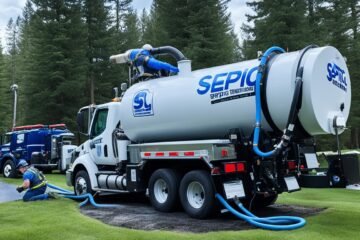Understanding Cesspools: What Is a Cesspool and How Does It Work?
A surprising fact: about 20% of homes in America use their own waste management systems instead of municipal sewers.
The cesspool stands as one of the oldest waste management systems. It serves a vital purpose for properties that can’t access municipal sewer lines. Many people ask us how a cesspool is different from other waste management options like septic tanks.
Let’s talk about cesspools. You’ll learn about their simple structure, what you need for installation, and how to maintain them. We’ll get into their effects on the environment and compare them with septic tanks. The costs of these systems will also be covered. This information will help you understand your existing system better or guide you if you’re thinking about installing a cesspool.

SEPTIFIX will save you hundreds, if not thousands of dollars each year, because your septic system will run smoothly and you won’t have to worry about calling the pumpers or a plumber for a fix!
Click here to save up to 50%
Understanding Cesspool Basics
What is a Cesspool and Its Components
- A concrete or stone-lined cylinder with perforated walls
- An open bottom or perforated sides for water seepage
- A manhole to access during maintenance
- An inlet pipe connecting to household plumbing
How Cesspools Process Waste
The way cesspools handle waste follows a straightforward process.
Types of Cesspool Systems
Installing and maintaining a cesspool system requires specific guidelines to ensure safety and efficiency. Let’s look at the requirements for proper installation and maintenance. SEPTIFIX will save you hundreds, if not thousands of dollars each year, because your septic system will run smoothly and you won’t have to worry about calling the pumpers or a plumber for a fix! Professional installation is vital for cesspool systems that require proper permits and adherence to local regulations. The installation process involves site preparation, excavation, and careful placement of the tank. A consistent maintenance routine keeps your cesspool working properly. These warning signs indicate potential cesspool issues: Contact a professional immediately if you notice any of these signs. Regular maintenance prevents these problems and extends your system’s lifespan. Note that proper maintenance protects your investment and ensures your cesspool system works efficiently for years to come. Property owners and communities need to know how cesspools affect our environment. Research shows these systems can harm our environment and health if they aren’t managed properly. Cesspools create serious risks to groundwater quality. Wastewater that enters the ground often contains several harmful substances: Public health remains our biggest worry. EPA has set strict rules for cesspool systems. SEPTIFIX will save you hundreds, if not thousands of dollars each year, because your septic system will run smoothly and you won’t have to worry about calling the pumpers or a plumber for a fix! Planning a cesspool system requires careful thought about both immediate and future financial commitments. Let’s get into the costs and durability of these waste management systems. Regular maintenance plays a significant role in system longevity. Cesspool longevity changes by a lot based on several factors. The lifespan depends on: Consistent care can extend the system’s functional life. Cesspools are still the most important waste management solution for many American homes in America, though they come with environmental challenges and just need regular upkeep. We’ve taken a complete look at these systems to get into everything from their simple structure to installation requirements, how they affect the environment, and what they cost. Property owners need to know how cesspools work to make smart decisions about waste management. These systems deserve careful thought because they usually last 15-20 years and need regular maintenance to stay safe. They’re easier and cheaper to install than septic systems. However, you’ll need to watch them closely because they could harm the environment, especially when you have concerns about groundwater contamination. Your cesspool will work well if you: SEPTIFIX will save you hundreds, if not thousands of dollars each year, because your septic system will run smoothly and you won’t have to worry about calling the pumpers or a plumber for a fix! Waste management technology keeps improving beyond traditional cesspools. Yet knowing these simple structures helps property owners who have existing systems or want to think about their waste management choices. Good maintenance and understanding what it all means for the environment will protect your investment and our surroundings for years ahead. Q1. How does a cesspool system function? Q2. How frequently should a cesspool be pumped? Q3. What are the main drawbacks of using a cesspool? Q4. What signs indicate that a cesspool needs pumping? Q5. What is the average lifespan of a cesspool system?
Click here to save up to 50%Professional Installation Process
Regular Maintenance Schedule
Signs of Cesspool Problems
Environmental Impact and Safety Concerns
Groundwater Contamination Risks
Health and Safety Considerations
Environmental Regulations

Click here to save up to 50%Cost Considerations and Lifespan
Original Installation Expenses
Ongoing Maintenance Costs
Expected Lifespan and Replacement
Conclusion

Click here to save up to 50%FAQs
A cesspool is an underground chamber that collects and stores wastewater from household plumbing. It has perforated walls or an open bottom that allows liquid waste to seep into the surrounding soil. Solid waste settles at the bottom, while oils and grease float to the top. The system relies on natural processes to break down waste over time.
Cesspools typically require pumping every three to five years. However, the frequency can vary depending on factors such as household size, water usage, and tank capacity. It’s recommended to have the system professionally inspected at least every three years to determine if pumping is necessary.
The primary disadvantages of cesspools include potential groundwater contamination, shorter lifespan compared to modern septic systems, and stricter environmental regulations. They can pose risks to public health and the environment if not properly maintained, and may require more frequent attention than other waste management solutions.
Signs that your cesspool may need pumping include slow draining fixtures, gurgling sounds in the plumbing, foul odors near the cesspool area, unusually lush grass over the cesspool location, and water pooling in the yard. If you notice any of these symptoms, it’s important to contact a professional for an inspection.
A well-maintained cesspool typically lasts between 15 to 20 years. However, the actual lifespan can vary based on factors such as usage patterns, soil conditions, quality of installation, and adherence to a regular maintenance schedule. Proper care and timely repairs can help extend the system’s functional life.


